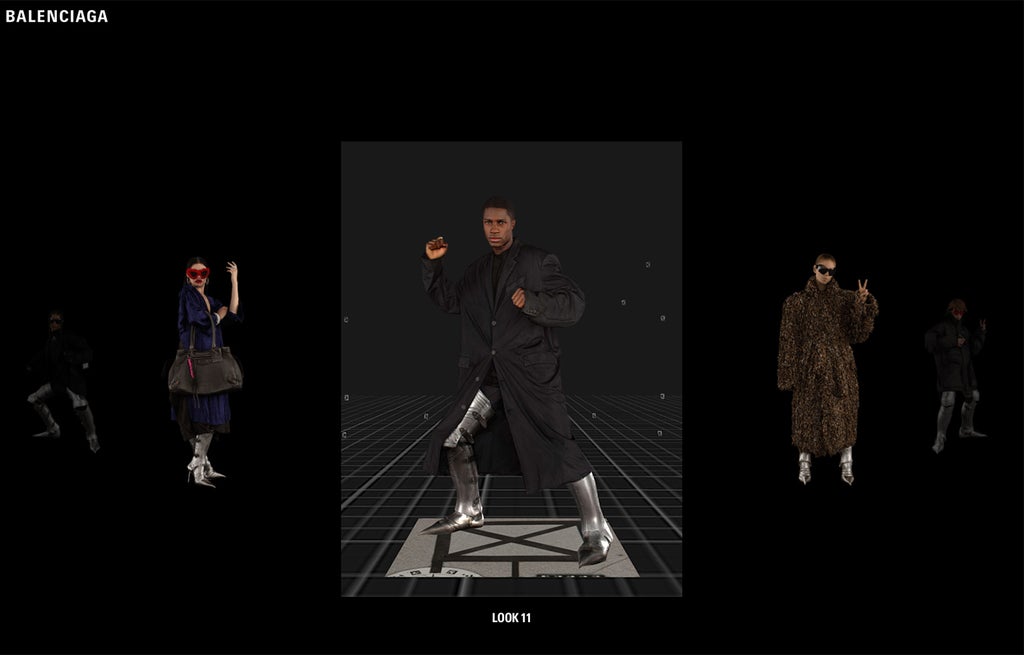
Over the past year, our lives have become increasingly digitalized in ways that were once hard to imagine. In-person meetings have been replaced by Zoom calls, we shop nearly exclusively online, and even learning has become virtual. It comes as little surprise then that digital fashion — which includes everything from live stream runway shows and 3-D collections to fashion you can buy in digital formats (in video games and crypto art) — has also accelerated.
In 2018, Scandinavian retailer Carlings released its first digital clothing collection in which customers could buy the “clothes” by sending in a photo of themselves to be “digitally tailored.” Since then, Tommy Hilfiger has committed to digitally creating, developing, and selling samples starting next spring of 2022; emerging designer Hanifa hosted an innovative 3-D fashion show; and the first crypto-fashion week took place.
While years ago, all these would have seemed like nonsensical concepts, these digital expressions of fashion have widespread appeal these days. We’re now accustomed to virtual fashion influencers like Lil Miquela, who has over three million followers on Instagram, digital Fashion Month shows, and new collections that debut within video games (see: Balenciaga’s Afterworld: The Age of Tomorrow). If this trend continues, could parts of the fashion consumption process, from production to wear, become entirely digital, too?

Given fashion’s role in the environmental crisis — projections show that the industry could be responsible for a quarter of the earth’s carbon budget by 2050 if nothing changes — the digital-first method of production and consumption presents an interesting opportunity. With this in mind, the University for the Creative Arts announced the launch of its first digital-only fashion course earlier this year. “Digital fashion has three applications: virtual fashion, e-commerce, and the digitalization of production,” Jules Dagonet, the head of its school of fashion, tells Refinery29. “[When] sustainability and digital fashion go hand-in-hand, and everyone wins. For the brands, it’s faster to produce and you’re producing garments only when a customer needs it. It’s also better for the environment.”
We produce almost twice the amount of clothing today compared to over 20 years ago. Dagonet believes that digitizing fashion production has a unique potential in addressing issues like overproduction. But, first, young designers need to be educated in these fields. “What’s keeping [companies] from embracing digital fashion technologies is the talent gap,” she explains. That’s where she says programs like UCA’s will have an important role to play.
Stephy Fung, a 3-D designer based in London, agrees. Because of the lack of targeted educational programs, many of today’s digital fashion designers are self-taught. “Digital fashion is set to increase in the future, and we need to have places, institutions, or online courses which help to teach or nurture the younger talent,” she tells Refinery29. Fung began working in the digital fashion space because of the possibilities it offered — “The fact that you can create something out of nothing really intrigues me” — and confirms that digital fashion has the potential to be more sustainable than physical fashion. “We do not need to source fabrics for testing, we don’t need to have fabrics to be made or to be sampled.” This, she says, allows designers to change cuts, colors, or fabrics without waste.
And while it can seem that digital-exclusive fashion — the kind of “clothing” that you can only enjoy via a screen — is only a consumer novelty, social media habits say otherwise. In an era of one-off social media “‘fit pics,” in which users sometimes only wear an item once for an Instagram post, retailers like DressX believe that here’s a market for clothing that doesn’t need to be produced at all. The company currently carries 200 digital items by 25 designers. Shoppers buy looks, which DressX then superimposes on an uploaded photo of the person.
Obviously, this process is greener than typical manufacturing. While compiling a report, DressX owners Daria Shapovalova and Natalia Modenova found that the production of their digital garments emits 97% less CO2 than physical garment. They also found that a digital garment, on average, saves 3300 liters of water per item.
The duo feels hopeful of the role that digital fashion can play in addressing the industry’s responsibility to the climate crisis, and believes that more brands will adopt the practices. “We are in the very early days of digital fashion but there is this curve of adoption,” Modenova told Refinery29. “Digital fashion is opening a big category that every brand will eventually have in their line.”
Though the environmental benefits are clear — most digital-only models require no manufacturing, packaging, delivery vehicles, or use of natural resources — Céline Semaan, the executive director of Slow Factory Foundation, points out that data itself can leave a carbon footprint. The rise in NFT art sales has spotlit how incredibly energy-consuming and ecologically destructive blockchain technology can be. “Digital is not necessarily always less impactful on the environment,” says Semaan.
According to Semaan, going digital also doesn’t help solve fashion’s sustainability problem: “We are producing far more than we actually need, and producing more digitally does not resolve that issue.” According to her, fundamental change can only be achieved by producing less.
Like what you see? How about some more R29 goodness, right here?
Copenhagen Is Leading Fashion Week Sustainability
Powered by WPeMatico






